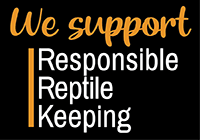How to Place Thermometer and Hygrometer Probes

How to Place Thermometer and Hygrometer Probes
Written by Mariah Healey, ReptiFiles.com
Because they’re ectotherms (“cold-blooded”), reptiles depend on the heat present in their environment to help regulate their metabolism. As you can imagine, this makes them very sensitive to the temperatures that they are exposed to. Temperatures that are too low can result in diminished appetite, lack of energy, and illness. Temperatures that are too high can cause heat stress and even stroke.
Probe-based thermometers and hygrometers are one of the best ways you can keep track of temperature and humidity in your pet’s environment. This is because they’re among the most accurate! However, they’re only as accurate as their probes are placed. A thermometer probe in the wrong place can trick you into thinking that your basking temperature is lower than it actually is. A hygrometer probe in the wrong place can trick you into thinking that your environment is wetter or drier than it actually is.
As a result, when your probes are improperly placed, you may think that your reptile’s environment has the right stats, but it actually doesn’t. And that’s when problems happen! So let’s go over how to place your thermometer, hygrometer, thermostat, and humidistat probes correctly and effectively.
Thermometer Probe Placement
You will need at least two thermometers and two probes to keep track of the temperature gradient inside your reptile’s enclosure: one for the basking spot, and one for the cool end. The one on the basking spot tracks basking temperature, the hottest available temperature in your enclosure. The one on the cool end tracks ambient (air) temperature, which is going to be the coolest available temperature in your enclosure. Together, these two measurements tell you about the full range of available temperatures in your pet’s environment.
If you’re using a stone slab for your basking surface, then the basking probe should go on top of the stone and within the heat lamp’s range of output. Your reptile will in all likelihood occasionally move this probe, so check it daily to make sure it stays in the right spot.
If you’re using a branch for your basking surface, then the basking probe should go on the branch directly under the heat lamp. You’ll need something to help tie the probe in place. Zip ties work great as long as you file down any residual sharp edges.
If you’re using a heat mat for a warm hide, place the thermometer probe on top of the substrate directly over the heat mat.
In a terrestrial enclosure, place the cool side probe on top of the substrate on the opposite side of the heat source.
In an arboreal enclosure, place the cool side probe in the shade but off the ground. You may need a zip tie to secure this one as well.
Hygrometer Probe Placement
You will need 1-2 hygrometers and 1-2 probes to keep track of the humidity inside your reptile’s enclosure. At a minimum, you should be tracking ambient humidity levels. Go one step further by tracking the humidity levels inside your reptile’s humid hide to make sure that it’s staying appropriately moist.
In a terrestrial enclosure, place the ambient humidity probe on top of the substrate in the middle of the setup. Check on this probe regularly to make sure it doesn’t get accidentally buried in the substrate.
In an arboreal enclosure, place the ambient humidity probe in the shade in the middle of the enclosure, up off the substrate. You will likely need a zip tie or some hot glue to secure it in place.
To track humidity levels inside your moist hide, simply place a separate hygrometer probe inside the moist hide. Easy!
Thermostat Probe Placement
Do you know what also uses probes? Thermostats. And there’s a lot of confusion about where to put those probes in order for the thermostat to do its job properly. The short answer: Put the probe at your reptile’s level wherever you want temperatures to be controlled.
Want to control basking temperature? Place the probe on the basking surface.
Want to control ambient temperature? Place the probe in the shade or on the cool side.
Want to control warm hide temperature? Place the probe inside the warm hide.
If you’re using a heat mat, there is no need to place the thermostat probe between the heat mat and the bottom of your enclosure or directly on top of the mat. If you wanted to control the temperature of the mat itself that would work just fine, but that’s not the goal here: you need to control the temperature that your reptile is feeling. So put the probe where your reptile will be!
It’s especially important to be aware of where your thermostat probe is, so check on it frequently to make sure it hasn’t gotten moved by your reptile, as that can significantly affect the temperatures it receives!
Humidistat Probe Placement
Humidistats are one of those little-used devices in our hobby that really should become more of a thing. Feeling anxious about humidity levels dropping too low in your setup? Don’t want to run a fogger constantly? A humidistat will turn the device on and off as needed to maintain an optimal environment.
The best way to do this is with the powerful combination of a humidistat and fogger. While misters run the risk of accidentally flooding your enclosure, a fogger simply atomizes water to humidify the air.
Treat the humidistat probe the same as you would a hygrometer probe: place it in the middle of the enclosure. Put it on the ground if you have a terrestrial enclosure since that’s where your reptile is going to be. If you have an arboreal enclosure, place the probe in the middle but off the ground, since that’s where your reptile is going to be experiencing its humidity instead (and humid air sinks!).
Conclusion
Reptiles require a lot of equipment to maintain their preferred environment, and that’s one of the things that can make them challenging to keep. Part of your responsibilities as a reptile owner is knowing how to use that equipment properly. Fortunately, when it comes to thermometers, hygrometers, thermostats, and humidistats, once you have the basics down, it’s pretty straightforward!
- Tags: Ball Python ball python bioactive ball python terrarium bedding Bioactive Bioactive terrarium blue tongue skink corn snake Crested Gecko Dart Frog Day Gecko Gargoyle Gecko Gecko hognose snake leopard gecko caresheert ReptiFiles reptile substrate Skink snake soils substrate Tarantula care bioactive Terra Fauna Terra Firma Terra Flora Terra Sahara Terrarium Tokay Gecko Tree Frog veiled chameleon Vivarium
- Rebekah Walenta










